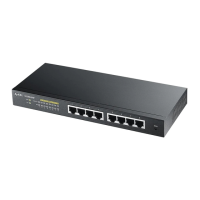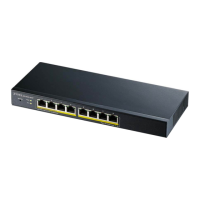Chapter 30 Configuration: Security
GS1900 Series User’s Guide
207
30.5.3 The Po rt Edit Sc re e n
Use this screen to configure the Port settings.
Click Co nfig ura tion > Se c urity > DoS > Po rt > Edit to open this screen.
Fig ure 207 Configuration > Security > DoS > Port > Edit
The following table describes the labels in this screen.
30.5.4 DoS Atta c k Type s
The following table describes the types of DoS attacks that the Switch can prevent when you enable the
DoS feature on the Switch and the ports.
Edit Select this check box to configure the properties of a port. Click the Edit button change the
properties of the port.
Cancel Click C a nc e l to discard the changes.
Table 153 Configuration > Security > DoS > Port (continued)
LABEL DESCRIPTIO N
Table 154 Configuration > Security > DoS > Port > Edit
LABEL DESCRIPTIO N
Port
Port List Displays the port index value.
State Select Ena ble to activate the port’s DoS feature.
Apply Click Apply to save the changes.
Cancel Click C a nc e l to discard the changes.
Table 155 DoS Attack Types
TYPE PACKET TYPE DESCRIPTION
DA_EQUAL_SA Layer 2 These attacks result from sending a specially crafted packet to
a machine where the source MAC address is the same as the
destination MAC address. The system attempts to reply to itself,
resulting in system lockup.
LAND Layer 3 IPv4/IPv6 These attacks result from sending a specially crafted packet to
a machine where the source host IPv4/IPv6 address is the same
as the destination host IPv4/IPv6 address. The system attempts
to reply to itself, resulting in system lockup.
UDP_BLAT / TCP_BLAT (Blat
Attack)
Layer 3 IPv4/IPv6 These attacks result from sending a specially crafted packet to
a machine where the source host UDP/TCP port is the same as
the destination host UDP/TCP port. The system attempts to reply
to itself, resulting in system lockup.

